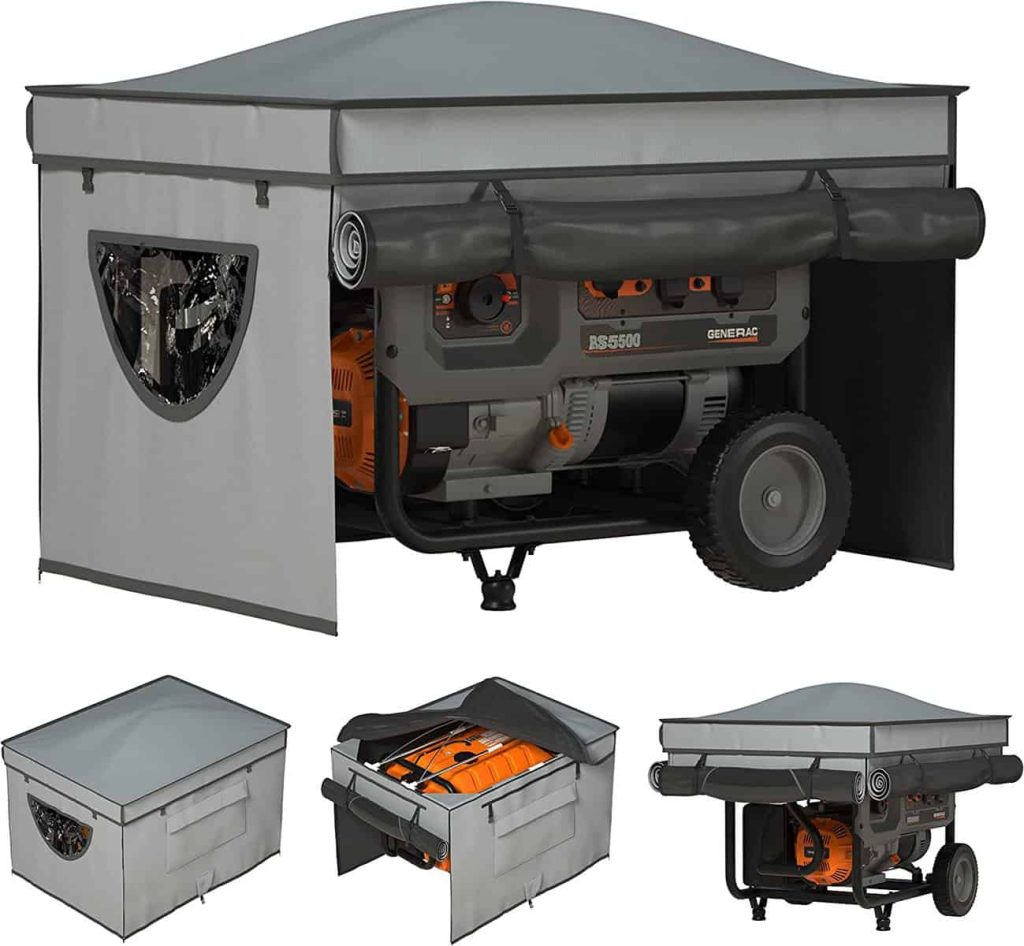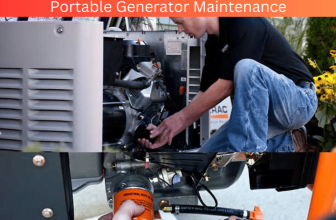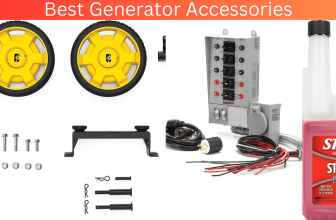Portable generators make life easier in countless ways, but only when they are properly maintained. Whether you’re a homeowner, a small business owner or an RV enthusiast, taking the time to properly maintain your portable generator can save you time and money in the long run.
In this article, we’ll explore key maintenance practices that will help keep your generator running optimally for years to come. Taking care of your portable generator is essential if you want it to continue providing reliable power whenever needed.
Regularly inspecting and servicing your generator can prevent costly repairs down the line and ensure optimal performance for years to come. With the right knowledge and tools, anyone can be a master of their own generator maintenance!

Understanding Your Generator’s Manual
When it comes to taking care of your portable generator, the best place to start is with the manual. It’s important to read through the entire document and familiarize yourself with all the instructions and safety warnings. Doing this will help you understand operation, maintenance, and storage requirements for your specific model. Plus, you can get a good idea of what types of maintenance will be required throughout its lifespan.
It’s also important to note that the manufacturer may update their manual over time with new information or safety updates. Make sure to check for those before using your generator so that you are always up-to-date on the latest developments.
And if ever in doubt about any aspect of its use or maintenance, don’t hesitate to contact customer service – they should be able to answer any questions you may have.
Now that you have an understanding of what’s included in the manual, it’s time to consider how best to plan and schedule regular maintenance for your portable generator.
Planning And Scheduling Maintenance
Maintaining your portable generator can be a daunting task, but it’s also necessary to keep it in top condition. Planning and scheduling maintenance is key to keeping your generator running smoothly and safely. Let’s take a look at the steps you need to take in order to plan and schedule maintenance for your generator.
To begin with, you need to make sure that you have all the right parts and tools on hand. This means having a good selection of spare parts like fuel filters, spark plugs, and air filters, as well as any other details that might be necessary should something go wrong. Additionally, ensure that you have all the right tools like wrenches and screwdrivers to repair or replace any broken parts.
Next, create a maintenance schedule for your generator based on its usage. Depending on how much use it gets, you may want to have regular weekly or monthly check-ups in order to inspect the generator for any signs of wear or damage. This will help keep it running efficiently and reduce the chances of breakdowns due to lack of maintenance.
From there, make sure to stick with your scheduled maintenance visits even if nothing seems wrong with the generator. Regular servicing is important for keeping your generator running smoothly for many years to come and avoiding costly repairs down the line.
With proper planning and scheduling of maintenance, you can rest assured knowing that your portable generator will always be up and running when you need it most.
Now let’s move onto how we can keep our generators clean…
Keeping The Generator Clean
It’s important to keep your generator clean if you want it to be in top-notch condition. If you’re going to use it outdoors, make sure you give it a good clean every now and then.
Check for dirt, dust, and debris that can easily accumulate on the exterior of the generator. You should also check for any signs of rust or corrosion on the metal parts. Clean off any mud or dirt with a soft cloth and warm water, paying extra attention to the air vents and crevices.
You’ll also want to make sure that all the connections on your generator are wiped down with a rag or brush. This includes the power outlets, fuel lines, oil plugs, spark plugs and other connections. Be sure to only use non-abrasive cleaners as they can damage these components if used incorrectly.
It’s also important to check all hoses regularly for any signs of wear or tear that could lead to leaks or malfunctions.
Keeping your generator well-maintained will ensure it’s in peak working condition at all times. Make sure you take the time to give it a thorough cleaning each time you use it so that it runs smoothly for years to come.
The next step is checking the battery so you can have confidence knowing your generator will always be ready when you need it most!
Checking The Battery
Taking care of your portable generator is important to keep it running for many years. Let’s focus on one of the key maintenance practices: checking the battery.
To get started, you’ll want to make sure that the battery terminals are clean and free from corrosion. This can be done by using a wire brush or a toothbrush to remove any dirt or rust buildup.
If you notice any corrosion, you’ll want to use a battery cleaning solution to remove it, followed by wiping down the terminals with a damp cloth.
Once your battery terminals are clean, it’s time to check the voltage of your generator’s battery. You’ll need a voltmeter for this step. Connect the voltmeter to the positive and negative terminals of your generator’s battery and take note of the reading on the display—it should read between 12-13 volts.
If it reads lower than that, you may need to replace your generator’s battery.
Testing the fuel system is the next step in maintaining your portable generator.
Testing The Fuel System
Now that we’ve discussed checking the battery, let’s turn our attention to testing the fuel system. To ensure efficiency, there are a few important steps you should follow for optimal performance of your generator.
Below is a quick summary of what needs to be checked periodically:
| Component | Frequency |
|---|---|
| Fuel Lines | Monthly |
| Fuel Tank | Quarterly |
| Carburetor & Air Filter | Yearly/As needed |
| Muffler & Exhaust System | Yearly/As needed |
It’s important to check all components of the fuel system regularly and address any issues quickly. This includes making sure all fuel lines are intact, properly connected and free from leaks or obstructions. You should also inspect the fuel tank and replace it if it’s corroded, cracked or leaking. Additionally, the carburettor and air filter should be serviced as needed – typically at least once a year. Finally, make sure the muffler and exhaust system are in good condition; they should not have any cracks or holes in them.
If all these steps are followed correctly, then you can rest assured that your generator will run properly and smoothly when you need it most. With that being said, let’s move on to inspecting the spark plugs for proper maintenance of your portable generator.
Inspecting The Spark Plugs
I pull out my spark plug wrench and throw back the cover of the generator. It’s time to take a look at the spark plugs, so I reach in and start unscrewing them one by one.
I inspect each one closely, checking for any signs of damage or wear and tear. If all looks good, I quickly clean it with some sandpaper and put it back in place.
Next, I check the gap between the electrode and the centre electrode. This is important because if it’s too wide or too narrow, then it could prevent your generator from starting up properly. Luckily, these are adjustable if they are out of spec, so I make sure to set them correctly before moving on to the next step.
Finally, I check that all the screws are tight and that everything is secure before replacing the cover of the generator.
With this done, it’s time to move onto another important step – replacing the air filter!
Replacing The Air Filter
Now that we’ve discussed the importance of inspecting your spark plugs, it’s time to move on to the next following tenancy task: replacing the air filter. This is an important step in ensuring your generator runs smoothly and efficiently.
First, locate the air filter cover on your generator. It is usually found near the engine and you may need to remove a few screws or bolts in order to open it.
Once you have opened the cover, take out the old filter and inspect it for any damage or dirt buildup. If necessary, use a shop vacuum or compressed air to blow out any debris inside the cover before installing the new filter.
Once you have located a suitable replacement filter, check its size against your old one to be sure it will fit properly. Then installace and close up the cover with its original screws or bolts. Make sure everything is securely fastened before starting up your generator again.
Now you can move on to cleaning your exhaust system – another essential part of keeping your generator running smoothly!
Cleaning The Exhaust System
Cleaning the exhaust system of your portable generator is an essential part of maintaining it. Doing this regularly is important, as excessive buildup can cause your generator to overheat and could lead to a fire.
To clean the exhaust system, first shut off the fuel supply and let the generator cool down for 15 minutes. Then, remove the exhaust cover and use a brush or rag to remove any dust buildup from the inside. Make sure you get all the corners and get rid of any debris that may have built up.
It’s also important to check for blockages in the exhaust pipe by looking through it after removing it from the generator. If you notice any blockages, make sure you clear them out with a wire brush or other suitable tool.
You should also keep an eye on the spark arrestor at all times; if it’s clogged up, replace it immediately so your generator runs safely.
Finally, once everything has been cleaned, put all parts back together securely and make sure they are tightened properly before turning on your generator again. This will ensure that your portable generator runs smoothly and safely at all times.
With regular maintenance like cleaning the exhaust system, you can rest assured knowing that you’re taking proper steps to protect your investment.
Winterizing The Generator
Winterizing your generator is a critical step to ensuring its longevity and performance. With the right maintenance, it will serve you reliably for many years.
Winterizing the generator includes draining any fuel that’s left in it, cleaning out the air filter, adding a fuel stabilizer, checking all connections for corrosion or damage, and topping off any fluids as necessary.
One of the most important aspects of winterizing your generator is draining all fuel from the tank and carburetor. This prevents any leftover fuel from gumming up and corroding components during storage.
To do this, first make sure your generator is turned off and cooled down before opening up any panels or making adjustments. Then drain out any remaining fuel by disconnecting the fuel line from the carburettor.
Once you’ve drained out all of the fuel, be sure to clean out the air filter with compressed air or replace it if needed. Fuel stabilizers are also a great way to protect your machine against corrosion while in storage; they help keep gasoline fresh and prevent clogging due to condensation build-up.
Finally, look over all connections to ensure they are tight and free from corrosion or damage – this will help keep your generator running optimally when you need it most.
Storing your generator properly will go a long way towards preserving its reliability for years to come.
Storing The Generator Properly
Storing your portable generator correctly is essential for its longevity and proper functioning. As such, I take extra care when it comes to putting it away after a job.
Firstly, I make sure that the fuel tank is empty prior to storage. This ensures that the fuel doesn’t spoil over time and clog up the system.
Secondly, I always check the oil level before putting it away in my shed or garage. Keeping the oil level at an optimal level will also help extend its service life.
Lastly, I make sure to give the generator a good clean before storing it away; this will prevent dust and debris from building up over time and clogging up its working parts.
These steps will ensure your generator is ready to go whenever you need it again.

Frequently Asked Questions
How Often Should I Use My Generator?
Using your generator often is a great way to make sure it stays in top condition. It’s important to be aware of the manufacturer’s instructions and recommendations – but as a general rule, you should aim to use it at least once every two weeks.
This will help ensure any lubricants are kept fresh and that all components are working properly. Plus, running your generator regularly can help you identify any potential problems before they become major ones.
What Type Of Oil Should I Use For My Generator?
When it comes to your generator, the type of oil you use is an important factor in making sure it runs smoothly.
You’ll want to make sure you’re using oil specifically designed for portable generators, as other types may not work as well or cause damage over time.
Look for a long-life oil with detergents and dispersants to help keep your engine clean and running efficiently.
Make sure you always check your owner’s manual for specific oil recommendations and replace the oil regularly – this will help ensure your generator is always ready when you need it!
How Do I Know When The Generator Needs To Be Replaced?
If you’ve had your generator for a while, it’s important to know when it’s time to replace it.
You’ll want to look for any signs of wear and tear, such as frayed electrical cords or visible rust.
Listen for noises that indicate the engine may be slowing down,, and check the oil level before each use – if it is low or dirty, this can be a sign that the generator needs replacing.
Pay attention to how often you have to refuel too – if you find yourself having to do this more frequently than usual, then this could be an indication that the generator isn’t functioning as efficiently as it should.
How Can I Ensure The Generator Is Running Safely?
You want to ensure your generator is running safely, and that’s a great idea! To ensure it’s running properly, there are a you need to followaintenance practices you need to follow.
First, keep the generator clean and free of dirt and debris.
Secondly, check the fuel lines for signs of wear or damage.
Finally, make sure to use fresh fuel in your generator, as old fuel can cause issues.
These simple checks will ensure your portable generator runs safely and efficiently.
Can I Use The Generator In Rain Or Wet Conditions?
Yes, you can use your portable generator in rain or wet conditions – but it’s important to do so safely.
When running in wet conditions, be sure to keep the generator dry and covered with a waterproof tarp or canopy.
It’s also important to ensure you’re using the right extension cord for outdoor use and keeping any connections away from puddles or standing water.
Finally, don’t forget to check your generator regularly for signs of water damage.
By taking these precautions and following key maintenance practices, you’ll be able to keep your generator safe and running reliably no matter the weather!
Conclusion
Maintaining your portable generator is essential to ensure it remains in good working order. Taking the time to care for it properly will help extend its life and save you money in the long run.
There are a few key maintenance practices that you should follow to keep your generator running smoothly and safely. Make sure to use the correct type of oil, check the filters regularly, and replace parts when needed.
Additionally, make sure never to use your generator in wet or rain conditions as this can cause damage or even malfunctioning.
Following these tips will help ensure that your portable generator remains in great condition for many years to come!




